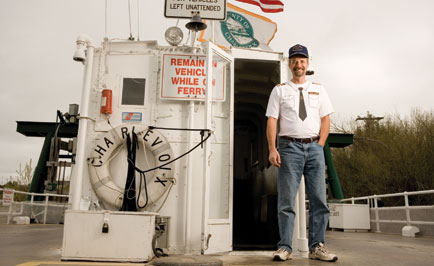World’s shortest ferry ride
Meet Bob Pawlus, captain of the slow-chugging, cable-guided ferry, the Ironton
By Patty LaNoue Stearns, Photo by Todd Zawistowski
Each year from mid-April to the day before Thanksgiving, 54-year-old Bob Pawlus works 20 hours a week as captain of the slow-chugging, cable-guided ferry, the Ironton, operated by the Charlevoix County Transportation Authority. Pawlus hauls cars, bikes, humans, pets and sometimes ambulances across the narrows of the South Arm of Lake Charlevoix, near M-66, on one of the world’s shortest ferry rides.

Originally operated in 1876 with hand cables and the help of passengers, the “new” ferry was built in 1926 and sports a noisy diesel engine. The Ironton operates daily from 6:30 a.m. to 10:30 p.m. Fares: $3.25 per car, 50 cents per person (without vehicle or bicycle), $1 with bicycle. A book of 20 tickets is $45.
Why is the Ironton listed in Ripley’s Believe It or Not?
The former captain, Sam Alexander, who lived nearby, logged 15,000 miles while never being more than a quarter mile from home.
How short is the ride?
It’s 610 feet; the ride takes three minutes or less. The water is about 40 feet and the cables drop down to 25 feet. You have to drive around the lake an extra 18 or 19 miles when the ferry isn’t running.
What about that huge engine? Isn’t it a gas eater?
We have two 325-gallon diesel tanks that are filled every two weeks. The ferry goes 3 1/2 miles an hour and gets about 1.4 miles per gallon. It actually saves fuel because we can run four cars a trip and about 12 cars an hour. Last season we transported 65,000 cars.
What’s the best part about your job?
I love my job—everybody who takes a ride is always in a good mood. It’s very flattering—people are always telling me, “You’ve got a great job,” or “I want your job.” People in the military salute me. I consider that a sign of great respect. And every day there’s a story.
Tell us more. Like the little girl who got on and said, “Where are the fairies?”
Or one lady who gets violently seasick. She got all worked up about taking the ferry the day before—she was dreading getting on the boat. After the ride, she couldn’t believe she fretted so much. Then there was the person in the minivan that got off on the Boyne City side and realized he rode the wrong way. I had a convertible full of six people in their fifties—perfectly sober—and they kept lifting their arms in the air and screaming as they crossed.
What about transporting ambulances? Can you rev up the engine?
I try to go faster. Under ideal conditions, I can cross in 2 ¾ minutes.
What’s your biggest challenge on the job?
When I get a group of bicyclists, like 25 at once. Their fare is $1, and sometimes I have to make a lot of change.
What happens if people get on the ferry and discover they have no cash?
I give them the address to our county clerk, or direct them to the office. It really doesn’t happen much.
What’s it like to pilot the ferry in November?
Sometimes it can snow two inches an hour. That flat steel deck gets very slippery. But I’ve never fallen in.
